Rudbaxton is situated on the ancient turnpike road from Haverfordwest to Fishguard, and lies about four miles north of Haverfordwest, and was home to two country estates, Withybush and Poyston. The Church of St. Michael’s contains a War Memorial to the men of the Parish who fell during the Great War, also a separate memorial to Private J. Richards, and a fine marble memorial to its most famous resident, Lieutenant-General Sir Thomas Picton, who was killed at the Battle of Waterloo.
The Great War, 1914-1918
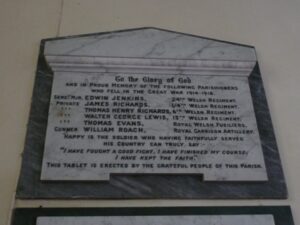
Thomas Evans, Private, 38532, Royal Welsh Fusiliers. Thomas was born at Prendergast in 1866. He was a gardener prior to the war and resided with his wife Phoebe Evans and their two children at Myrtle House, Crundale. Thomas enlisted at Haverfordwest into the Welsh Regiment, with the service number 39392, taking 14 years off his age. On 12 December 1915 he was transferred to the 2nd Garrison Battalion, Royal Welsh Fusiliers, which were on Garrison Duties in Egypt. Thomas became ill and died in hospital of pneumonia on 13 June 1916, aged 50. He is buried at Cairo War Memorial Cemetery, Egypt, in Grave Ref. F. 95.
Edwin Jenkins, Company Sergeant Major, 320011, Welsh Regiment. Edwin was born at Walwyn’s Castle, and enlisted at Haverfordwest into the Pembroke Yeomanry prior to the war, with the service number 133. The Pembroke Yeomanry formed at Tenby for war on 4 August 1914, before moving to the Norfolk coast as a Garrison unit. During March 1916 the battalion sailed for Egypt, where the South Wales Mounted Brigade became absorbed in 4th Dismounted Brigade. On 2 February 1917 the battalion merged with the 1/1st Glamorgan Yeomanry, and formed the 24th (Pembroke and Glamorgan Yeomanry) Battalion, Welsh Regiment in 231 Brigade, 74th Division. The Division then took part in the Palestinian campaign, and was present at the Battle of Gaza, and the capture of Jerusalem in December 1917. In May 1918 the Division moved to France, and took the line on the Lys. Later that year it moved to the Somme, and took part in the Battle of Epehy, where the 24th Welsh was tasked with the capture of the Hindenburg Outpost defences at Gillemont Farm on 21 September 1918. Edwin must have been one of the many casualties suffered by the battalion that day. He died of wounds on 26 September 1918 at a Casualty Clearing Station, and is buried at Honnechy British Cemetery, France, in Grave II. C. 50.
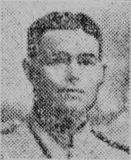
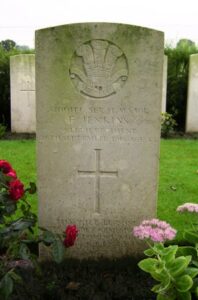
Walter George Lewis, Private, 54170, Welsh Regiment. Walter was the son of Thomas and Ellen Lewis, of Poyston Cross, Haverfordwest. He enlisted at Haverfordwest into the army, and was posted to the 13th Battalion, Welsh Regiment, which was in France as part of 114 Brigade, 38th (Welsh) Division. The Division had been in France since December 1915, and had been initiated into trench warfare in the Fleurbaix Sector. In June 1916 it moved to the Somme, where it took part in the famous capture of Mametz Wood from 7 July 1916. After a month in reserve at Hebuterne, the Division moved to Ypres, where it was to hold the line at Boesinghe for the next year, taking part in the opening of the Battle of Passchendaele, when the Welsh captured Pilckem Ridge. After spending the winter at Armentieres, the Welsh were moved back to the Somme in March 1918, and took the line at Aveluy Wood, north of Albert. From here on 22 August 1918 the Division launched their drive across the old battlefields of 1916, towards the mighty Hindenburg Line. Walter was killed just over a week into the great offensive, during the Battle of Morval on 1 September 1918. He was just 19 years old, and is buried at Morval British Cemetery, France, in Grave Ref. A. 18.
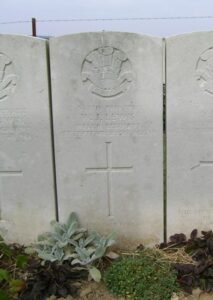
James Richards, Private, 466, Welsh Regiment. James was the son of James and Lizzie Richards, of Poyston Lodge, Haverfordwest, and served with ‘B’ Company of the local Territorial unit, the 1/4th Battalion, Welsh Regiment. The battalion was attached to 159 Brigade, 53rd (Welsh) Division, and was sent to the Mediterranean, landing on Gallipoli on 8 August 1915. The 4th Welsh took part in several fierce battles hereafter, before the campaign bogged down for the winter. James was killed at Gallipoli on 26 November 1915. He was 20 years old, and is buried at Lala Baba Cemetery, Gallipoli, in Grave Ref. II. F. 1. He is also commemorated on a separate plaque within St. Michael’s Church.
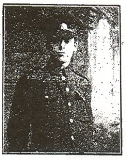
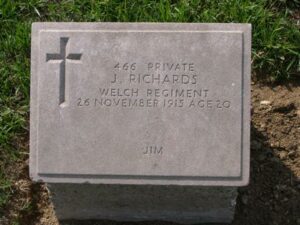
Thomas Henry Richards, Private, 265368, Welsh Regiment. Thomas was the son of Essex and Martha Richards, of Rathe Cottage, Rudbaxton, and had served during the war with the 6th Battalion, Welsh Regiment. The battalion had formed for war at Swansea on 4 August 1914, attached to South Wales Brigade, Army Troops. On 29 October 1914 the battalion landed at Havre, where it was used as a Labour Battalion. On 5 July 1915 it transferred to 84 Brigade, 28th Division, then on 23 October to 3 Brigade, 1st Division, where it became the Pioneer Battalion in 1st Division. At the signing of the Armistice on 11 November 1918, the battalion was at La Vallee Mulatre, N.E. of Bohain, and was selected to remain as part of the occupational forces. Thomas was sadly to become the last casualty of war from Rudbaxton. He was one of many men to survive the war only to become ill with influenza. He died on 4 February 1919, aged 25, and is buried at Les Baraques Military Cemetery, Sangatte, France, in Grave Ref. VIII. B. 1.
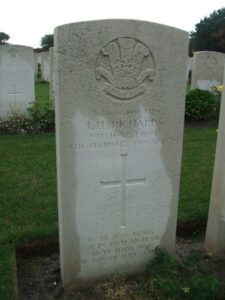
William Roach, Gunner, 46857, Royal Garrison Artillery. William was the son of William and Elizabeth Roach of Poyston Cross, Rudbaxton. He worked as a farm labourer prior to the war and enlisted at Haverfordwest into the Royal Garrison Artillery. William served with the 68th Siege Battery on the Western Front, and was wounded whilst the Battery was on the Somme in August 1916. He was evacuated to the Base Hospital at Abbeville, where he sadly died of his wounds on 19 August 1916, aged 21. William is buried at Abbeville Communal Cemetery, France.
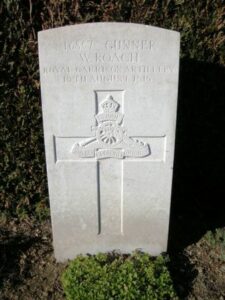
World War Two, 1939-1945
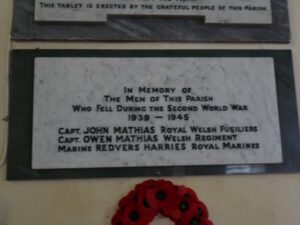
Redvers Joseph Harries, Marine, PO/X105411, Royal Marines. Redvers was born on 27 March 1921, the son of Benjamin John and Martha Ann Harries, of Crundale. He served with the Portsmouth Division, Royal Marines, but at present little else is known of him. Redvers died at Winchester on 23 April 1943, at the age of 22, of injuries suffered during an accidental fall. He is buried at Crundale Congregational Chapelyard, in the North east corner.
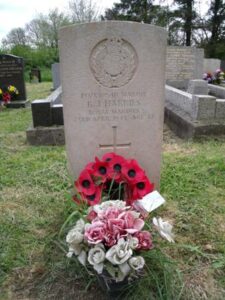
John Percival Mathias, Captain, 177652, Parachute Regiment. John was the son of Thomas Henry and Maggie Mathias, and the Husband of Gladys Emma Mathias, Of Milford Haven. He originally served with the 10th Battalion, The Royal Welch Fusiliers, which was converted to the 6th Battalion, The Parachute Regiment. John took fought with the battalion in North Africa, and took part in the landings at Sicily, and was killed on 10 September 1943 during the invasion of mainland Italy, when HMS Abdiel was bombed and sank in Taranto Harbour. He was 30 years old, and is commemorated on the Cassino Memorial, Italy.
Owain Ernest Mathias, Lieutenant, 117951, Glider Pilot Regiment. Owain was the son of Lieutenant-Colonel T. G. Mathias, DSO, and Mrs. Mathias, of Crundale, Pembrokeshire. He was originally commissioned into the Welch Regiment on 10 February 1940, before being attached to the King’s Shropshire Light Infantry. From there, Owain volunteered for service with the 1st Glider Pilot Regiment, where he embarked on a 12 week course to become a pilot, followed by another 12 weeks training on the Hotspur Glider. The 1st Glider Pilot Regiment was then sent to the Mediterranean, where they took part in the invasion of Sicily, called Operation Husky, and it was here, during the opening of the assault, that Owain was killed on 9 July 1943, when his glider became one of 69 to crash into the sea. He was 23 years old, and is commemorated on the Cassino Memorial, Italy, on Panel 12.
Sir Thomas Picton
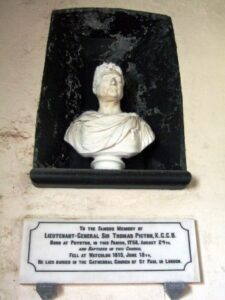
Thomas Picton was born at Poyston, the son of Thomas Picton. He obtained his commission in 1771, joining the 12th Regiment of Foot, which was based at Gibraltar, and he became Captain by January 1778, when he returned to Britain. After twelve years in retirement at Poyston, Picton went to the West Indies, where he was promoted Major, and joined the 58th Foot. He was present at the capture of St. Lucia, and was then made Governor of Trinidad. In October 1801 he was gazetted Brigadier-General, before returning to Britain in 1803, where he was tried on charges of brutality while as Governor of Trinidad. Picton was found guilty, but was acquitted at a retrial, before becoming promoted to Major-General, and becoming Governor of Flushing, in Holland. In 1810 he accepted Lord Wellington’s request to rejoin the Army, and commanded his own division during the Peninsula Wars. He was made G.C.B. in 1915 for his services in Spain, and then took part in his final action, during the Battle of Waterloo on 18 June 1915, when he was killed by a musket ball through his temple. His body was brought home to London, and buried in the family vault at St George’s, Hanover Square, and two monuments were erected in his memory, one at St Paul’s Cathedral, by order of parliament, and another at Carmarthen by subscription, the king contributing a hundred guineas. Thomas is commemorated by a white marble memorial within St. Michael’s Church, Rudbaxton and by the impressive Picton Monument in Carmarthen.